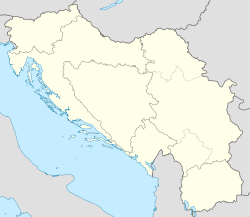1979 Montenegro earthquake
| Date | April 15, 1979 |
|---|---|
| Origin time | 06:19:44 |
| Magnitude | 6.9 Mw |
| Depth | 10 km (6.2 mi) |
| Epicenter | 42°02′N 19°10′E / 42.03°N 19.17°ECoordinates: 42°02′N 19°10′E / 42.03°N 19.17°E |
| Areas affected | Montenegro, Albania |
| Max. intensity | X (Extreme) |
| Peak acceleration | .46g |
| Tsunami | .6 m (2 ft 0 in) |
| Aftershocks | 6.3 Ms May 24 at 17:23 UTC |
| Casualties | 136 dead, 1,000+ injured |
The 1979 Montenegro earthquake occurred on April 15 at 06:19 UTC with a moment magnitude of 6.9 and a maximum Mercalli intensity of X (Extreme). It was the most devastating earthquake on the territory of present-day Montenegro, then part of SFR Yugoslavia, and was mostly felt along the Montenegrin and Albanian coastline. It was also felt in other parts of the country (in Podgorica with intensity of VII, in Sarajevo and Skopje V-VI, in Belgrade IV, in Zagreb and Ljubljana III-IV) and was followed by more than 90 aftershocks stronger than 4.0 on Richter scale.
Budva's Old Town, one of Montenegro's Cultural Heritage Sites, was heavily devastated. Of the 400 buildings in Budva's Old Town, 8 remained unscathed from the earthquake. The 15th century walls and ramparts protecting the Old Town were severely damaged as well. Praskvica Monastery, located between Miločer and Sveti Stefan in the Budva Municipality, suffered greatly too. The church inside the monastery had all but totally collapsed, whereas the frescoes in the monastery were completely damaged.
The walls surrounding Stari Bar had suffered very little damage from the earthquake, in comparison to the Aqueduct in Stari Bar which was completely destroyed. Herceg Novi, the youngest town on the Montenegrin coast, suffered heavily as well. Parts of the walls of Herceg Novi's Old Town fell into the Adriatic. Ulcinj's Old Town, another Montenegrin Cultural Heritage Site, was almost totally devastated. The centuries-old Balšić Tower in Ulcinj nearly collapsed as a result of the earthquake.
Over 450 villages were razed to the ground. In addition, many villages in the regions of Crmnica, Grbalj, Krajina and Paštrovići were in danger of near total collapse. Further inland, Cetinje, Danilovgrad, Nikšić and Montenegro's capital city, Titograd (present Podgorica) were damaged as well, but not as severely.
...
Wikipedia

